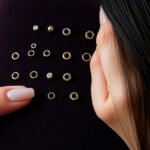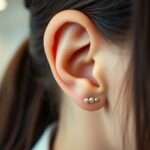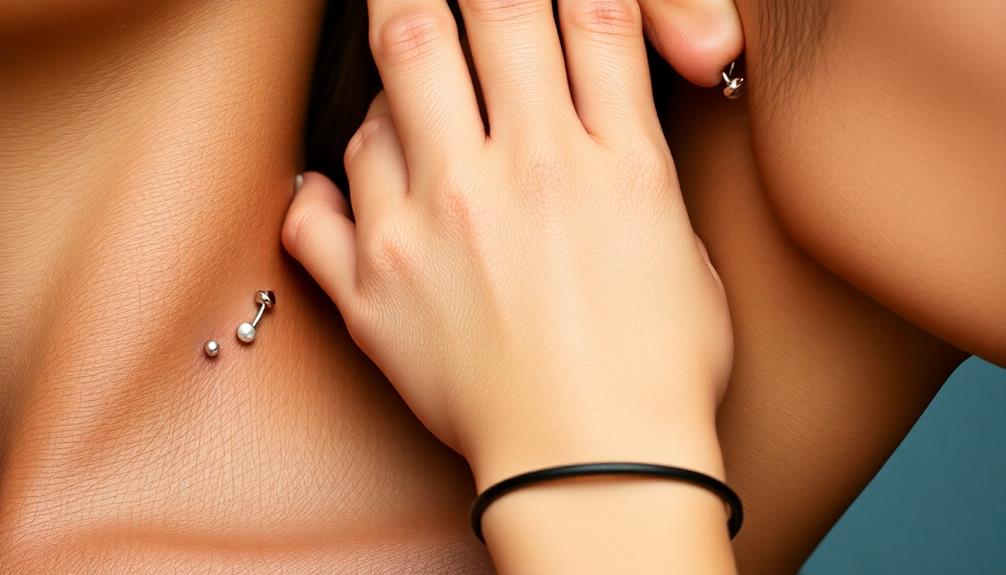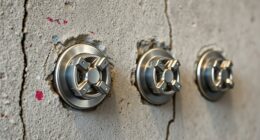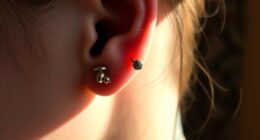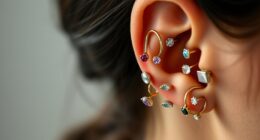Nostril piercings offer a classic, elegant look, while septum piercings create a bold, edgy statement. If you want versatility in jewelry and a timeless appeal, nostril piercings might be right for you. However, if you prefer something more daring and easier to hide, consider a septum piercing. Pain levels are similar, but septum piercings may hurt slightly more. Healing times differ too, with nostrils taking 4-6 months and septum around 3-4 months. Your personal style and comfort should guide your choice. Keep exploring to discover more about each option's unique attributes and care tips.
Key Takeaways
- Nostril piercings are more common and offer versatile jewelry options, while septum piercings create a bold, edgy statement.
- Healing time differs: nostril piercings take 4-6 months, whereas septum piercings heal in 3-4 months.
- Pain levels are similar, but nostril piercings may cause more initial discomfort, while septum piercings often recover faster.
- Aesthetic preferences play a significant role; choose nostril for delicate looks and septum for a rebellious style.
- Personal comfort and maintenance ease should guide your decision; nostril piercings require more visible aftercare compared to easily concealable septum piercings.
Overview of Nose Piercings

Nose piercings are increasingly popular, with two main types: nostril and septum piercings. Nostril piercings are the most common type, usually placed on either side of your nostril. They offer a variety of jewelry options, including studs, hoops, and screws, allowing you to express your style.
On the other hand, septum piercings are located in the cartilage wall between your nostrils, making them easier to hide when needed.
When pondering healing time, nostril piercings generally take about 4 to 6 months to heal, while septum piercings require around 3 to 4 months. Individual healing rates and aftercare practices play a significant role in this process.
You'll also want to reflect on the gauge sizes for jewelry: nostril piercings typically use 18- or 20-gauge needles, while septum piercings often use 16- or 14-gauge hollow needles.
Ultimately, your personal comfort, pain tolerance, and aesthetic preferences will guide your decision. Whether you lean toward the common appeal of nostril piercings or the edgy look of septum piercings, both can beautifully complement your facial features.
Comparing Pain Levels

When considering pain levels for nostril and septum piercings, you'll find that nostril piercings generally score around 4 out of 10 on the pain scale. This is often described as a brief sting during the process.
On the other hand, septum piercings may be perceived as slightly more painful, depending on your anatomy and individual pain tolerance.
Here are some key points about the pain experience:
- Nostril piercings usually involve a short, sharp sensation.
- Septum piercings can lead to watering of the eyes for some.
- Both piercings result in minimal discomfort after the initial sting.
- The entire appointment lasts about 15 minutes, making it a quick process.
- Your personal pain threshold can greatly influence how you perceive the experience.
Healing Process Insights

The healing process for nostril and septum piercings varies, and understanding these differences can help you navigate your aftercare more effectively. Nostril piercings typically take about 4 to 6 months to heal, while septum piercings usually require around 3 to 4 months.
Keep in mind that individual healing rates can vary considerably based on your personal health and how well you follow aftercare guidelines.
During the healing process, nostril piercings may cause more pain, but septum piercings often involve brief discomfort followed by quicker recovery. Regardless of the type you choose, it's vital to monitor the healing process closely.
Pay attention to any signs of infection, such as increased pain or unusual discharge, and consult a professional if these occur.
To promote proper healing and reduce the risk of infection, it's important to stick to a consistent aftercare routine. This includes saline rinses and avoiding unnecessary touching of the jewelry.
Aftercare Guidelines

After getting your nostril or septum piercing, proper aftercare is essential for a smooth healing process.
You'll want to focus on cleaning techniques, jewelry handling tips, and keeping an eye out for any common healing issues.
Let's go over what you need to do to guarantee your piercing stays healthy and irritation-free.
Cleaning Techniques
Maintaining cleanliness is essential for the health of your nostril or septum piercing. Proper cleaning techniques can help promote healing and prevent infection. Here are some key guidelines to follow:
- Rinse your piercing with saline solution 2-3 times a day to keep the area clean.
- After rinsing, use clean water to thoroughly rinse the piercing and gently dry it with a clean paper towel.
- Minimize touching the jewelry or piercing site to reduce the risk of irritation and infection.
- Avoid applying makeup or harsh chemicals near the piercing to prevent irritation.
- If crust forms around the piercing, gently soak it with saline solution to soften and remove it without pulling on the jewelry.
Jewelry Handling Tips
Ensuring proper handling of your jewelry is essential for the health of your nostril or septum piercing. Here are some tips to help you through the healing process:
| Tip | Details |
|---|---|
| Wash Your Hands | Always wash your hands thoroughly before touching your nose jewelry. This helps prevent bacteria transfer. |
| Clean with Saline Solution | Use a saline solution or rinse to gently clean your piercing. Apply it with gauze or a cotton ball to avoid irritation. |
| Dry with a Clean Paper Towel | After rinsing, dry the area with a clean paper towel. Avoid cloth towels as they can harbor bacteria. |
| Avoid Touching and Makeup | Refrain from excessive handling of the jewelry and avoid applying makeup around the piercing to minimize irritation. |
Following these guidelines will help you maintain a healthy healing process. If you have any concerns, consult your experienced piercer for personalized advice. Remember, taking care of your nose jewelry is vital for a successful healing experience!
Common Healing Issues
Even with proper jewelry handling, you might encounter some common healing issues with your nostril or septum piercings.
It's vital to follow aftercare guidelines to manage these challenges effectively. Here are some issues you may face:
- Crusting: A natural part of the healing process, crusting can be uncomfortable. This can be alleviated by cleaning the area gently with saline solution, as proper piercing care and hygiene is fundamental during healing.
- Inflammation: Your body may react with mild inflammation, which is typically manageable.
- Swelling: Initial swelling is common, especially with septum piercings.
- Tenderness: You might feel tenderness around the piercing site for a few days.
- Infection: Watch for signs like increased redness or discharge.
To minimize these healing issues, clean your piercings with saline solution at least twice daily.
Avoid harsh chemicals that can irritate the area. Refrain from touching or twisting the jewelry, as this can lead to complications and prolong healing.
Monitor your piercings for any signs of infection, and don't hesitate to seek professional advice if you notice persistent pain or abnormal discharge.
Proper aftercare is fundamental to guarantee your piercings heal without significant issues, allowing you to enjoy your new look confidently.
Cost Analysis

When you're considering a nostril or septum piercing, it's crucial to understand the costs involved. The basic fee for either piercing typically ranges from $30 to $60, depending on the reputation and location of the studio you choose.
This initial cost is just the start, as you'll also need to factor in the jewelry. Quality jewelry, often made of implant-grade titanium, usually starts at around $40. When you combine the piercing fee and the cost of the jewelry, the total expense can easily exceed $70 at reputable studios.
It's wise to explore multiple studios, as prices can vary considerably. Some studios might even offer promotions, such as free piercings when you purchase jewelry, which can help offset your overall costs.
Aesthetic Preferences

Choosing between a nostril and septum piercing often hinges on your aesthetic preferences. Each option offers unique qualities that can enhance your look, reflecting your individuality. Here are some aspects to contemplate:
- Versatility: Nostril piercings allow for various jewelry styles, like studs, hoops, and screws.
- Aesthetic Appeal: Nostril studs offer a classic, understated look, while septum rings can create a bold, edgy statement.
- Facial Features: Nostril piercings complement diverse facial structures, whereas septum piercings often enhance specific nose shapes and are more noticeable from certain angles.
- Cultural Significance: Septum piercings symbolize individuality and personal expression, gaining popularity in contemporary fashion, while nostril piercings carry a traditional, timeless appeal.
- Personal Preference: Ultimately, your choice depends on what feels right for you and how each piercing resonates with your identity.
Both nostril and septum piercings have their aesthetic appeal, so contemplate how they fit with your overall look.
Whether you lean towards the classic charm of nostril piercings or the boldness of septum piercings, your decision should reflect your personal style and comfort.
Personal Style Considerations

Personal style heavily influences the decision between nostril and septum piercings. If you lean towards a more delicate aesthetic, nostril piercings might appeal to you. They come with various body jewelry options, like studs and hoops, that can enhance your facial features and offer a feminine touch.
Additionally, humor in communication, such as that found in seniors texting humor, can also reflect a playful side in your personal style. However, if you prefer making a bold fashion statement, septum piercings could be the way to go. Their edgy appearance can really stand out, and you can easily hide them by flipping the jewelry up when needed.
Personal comfort is essential too. Nostril piercings often require more careful aftercare due to their visibility and placement, while septum piercings are generally easier to maintain and conceal.
Your aesthetic preferences will guide you—whether you're drawn to the classic look of a nostril stud or the rebellious vibe of a septum ring.
Lastly, don't underestimate the influence of feedback from your peers. Opinions from your social circle can sway you towards a particular style that aligns with your personal identity.
Ultimately, choose the option that resonates most with your unique style and comfort.
Frequently Asked Questions
Should I Get My Nose Pierced on the Side or Septum?
Deciding between a side nose piercing or a septum piercing depends on your style preference and pain tolerance. Consider how visible you want it to be and how quickly you'd like it to heal.
What Hurts More, a Septum or Nostril Piercing?
Painful prickles pierce as you ponder: a septum's sting or nostril's nudge? Generally, nostril piercings might feel more intense, but individual experiences vary. Ultimately, it's your tolerance that decides what's truly tougher.
Which Heals Faster, Septum or Nostril?
Septum piercings generally heal faster than nostril piercings, taking about 3 to 4 months compared to the 4 to 6 months for nostrils. Proper aftercare's essential for both to guarantee a smooth healing process.
How Do You Know if Your Nose Is Suitable for a Septum Piercing?
Wondering if your nose can handle a septum piercing? Check the thickness of the columella, assess your nose's angle, and consult a professional. A faux hoop can help you visualize and feel the potential piercing.
Conclusion
Choosing between nostril and septum piercings is like selecting a path in a vibrant forest. Each trail offers unique sights and experiences. The nostril piercing might be the gentle stream, flowing with tradition, while the septum could be the adventurous trail, leading to bold expression. Whichever you choose, remember to embrace the journey ahead. With care and creativity, you'll blossom like the wildflowers around you, showcasing your individuality in this beautiful world of self-expression.
Hi, my name is Danielle, and I’m an author for piercings-body.com. I have a passion for writing and love to share my knowledge on all things body piercing-related. I’m also a huge advocate for safe body modification practices and believe everyone should be able to make informed decisions about their bodies. When I’m not writing or blogging, I enjoy spending time with my family and friends, practicing yoga, and exploring new places.





